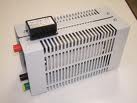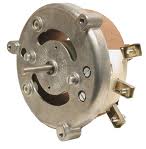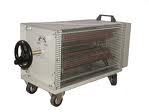Repair of rheostats and resistance boxes
 During repair rheostats and resistance boxes replacing or repairing resistance elements, cleaning burnt and replacing defective contacts, adjusting the action of the mechanical part of the rheostat, checking the protective grounding of the housing, measuring the insulation resistance, cleaning the tank from dirt and changing the oil, painting of the case and restoration of the inscriptions.
During repair rheostats and resistance boxes replacing or repairing resistance elements, cleaning burnt and replacing defective contacts, adjusting the action of the mechanical part of the rheostat, checking the protective grounding of the housing, measuring the insulation resistance, cleaning the tank from dirt and changing the oil, painting of the case and restoration of the inscriptions.
Among rheostat malfunctions, the most common are the following:
 1. Mismatch between the position of the handle of the rheostat and the position of the brush on the contacts. This defect appears due to improper fixation of the handle: it can reach the limiter, while one or two elements will remain disconnected.
1. Mismatch between the position of the handle of the rheostat and the position of the brush on the contacts. This defect appears due to improper fixation of the handle: it can reach the limiter, while one or two elements will remain disconnected.
To eliminate this malfunction, it is necessary to re-drill the hole for the stop and re-insert the stop that fixes the position of the handle.
2. Installation of contact surfaces not at the same level. Such a malfunction causes the brush to jump and burn the contacts.Eliminate it by placing and adjusting the contacts at the same level.
 3. Inappropriate resistance step values. To detect this malfunction, the resistances are checked using a measuring bridge in all positions of the rheostat and then the total resistance is measured. The deviation of the resistance value from the calculated one for rheostats made of constantan and fechral wire is allowed + 10%, and for cast iron resistors + 15%.
3. Inappropriate resistance step values. To detect this malfunction, the resistances are checked using a measuring bridge in all positions of the rheostat and then the total resistance is measured. The deviation of the resistance value from the calculated one for rheostats made of constantan and fechral wire is allowed + 10%, and for cast iron resistors + 15%.
If the resistance stages are incorrectly connected to the contact screws, the resistance stages must be connected again according to the circuit diagram.
In rheostats with cast iron resistors, this malfunction is less common due to the rigid fixation of the wires.
